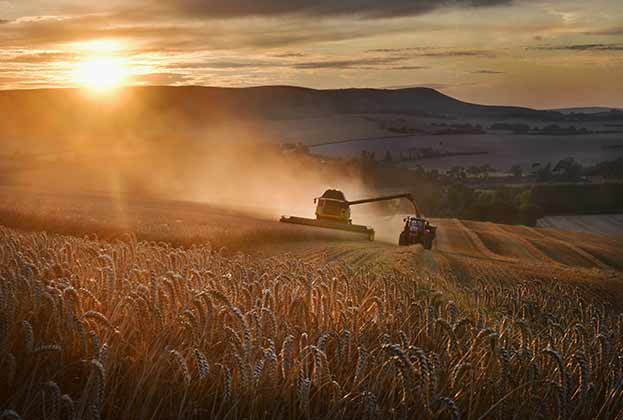Farmers are being asked to respond to the challenge of producing food for a growing population while reducing their climate impact and facilitating environmental recovery. The question is how?
Feeding the future
Reconciling our demand for food and its impact on the environment.
The agricultural transition is progressing in all devolved nations and it is clear the pendulum cannot swing too hard in favour of one land use or another – a balanced and integrated approach must be found to ensure the UK can produce food and meet its environmental ambitions and targets. A recent report by the Royal Society suggests we need an additional 4.4 million hectares of land to meet these targets, an area equivalent to twice the size of Wales. Innovative thinking is needed to maximise land use to meet our requirements.
Demands from land
Is food a public or private good?
Public goods are the general direction of travel. Prime Minister Rishi Sunak recently declared food is a public good and it could be argued that Scotland and Wales have always focused on food production due to their stronger national brands. All political parties have pledged their commitment to food production with statements such as ‘food security is national security’ and these sentiments have since been backed up in England as Defra has capped the overall proportion of a farm that can be entered into ten Sustainable Farming Incentive (SFI) options at 25% of the farm area.
What is required from our governments?
A cross-party political approach and commitment to UK food production and security is badly needed, one that transcends short-term political cycles and allows long-term planning aligned with the commitment to environmental protection, recovery and enhancement driven by the Environment Act 2021.
However, this appears unlikely and opportunities to bring more coherence to food policy have withered. The UK negotiated post-Brexit trade deals without a clear food strategy or security policy. The National Food Strategy (2022) by Henry Dimbleby continues to gather dust and the long-awaited Land Use Framework was not published before the dissolution of parliament. The framework had also been relegated to ‘guidance’ so it was appearing unlikely that it would have the impact necessary to reconcile competing demands anyway.
A cross-party political approach which aligns long‑term food production and food security planning with long‑term environmental targets is badly needed
Andrew Teanby, Associate Director, Rural Research
The government did announce an annual food security index to ‘monitor how we are maintaining and enhancing our current levels of food security’ and complement the three-yearly UK food security report. The first release in May 2024 comprised nine indicators and reported seven to be ‘broadly stable’ and two to have shown ‘some reduction in risks’ over the past year. The future of the index is now uncertain as the requirement to publish it was not put on a statutory footing.
Scotland is ahead of the devolved nations in creating a legislative framework. The Good Food Nation (Scotland) Act 2022 aims to transform Scotland into a ‘Good Food Nation’ where everyone can access healthy, sustainable, and locally sourced food. Key objectives of the Act include enhancing social and economic well-being, improving public health and nutrition, supporting environmental sustainability, promoting animal welfare, and contributing to educational initiatives. Accountability is ensured through progress reports every two years.
Food secure or self-sufficient?
A definition of food security was initially agreed at the World Food Summit in 1996: “food security exists when all people, at all times, have physical, social, and economic access to sufficient, safe, and nutritious food that meets their dietary needs and food preferences for an active and healthy life.”
Self-sufficiency is “the ability of a region or country to produce enough food without buying or importing additional food”. In its purest definition, self-sufficiency is about the volume of nutrients not the volume of a desired product. Self-sufficiency sits under the umbrella of food security, specifically ‘physical availability of food’.
Food security could exist without a high level of self-sufficiency if trade was stable. Trade can provide a variety of food but is also at risk due to shocks, such as global conflicts and climate change impacts. According to the AHDB, the UK produces around 60% of domestic consumption by value. Actual consumption is around 54% as part of the UK’s production is exported. There was a peak in the mid-1980s but a decline since.
Food security rests ultimately not on maximising domestic production, but on making the best use of land types which vary in quality and potential uses… There is a need to balance and integrate food production with environmental factors to support efficient and sustainable land use.
Andrew Teanby, Associate Director, Rural Research
A key influence on food production systems is the cost to the consumer. Food and Farming Director Adrian Matthews argues this has driven increased specialisation and intensification of production, which can lead to pressure on the environment. One example is the increase in broiler chicken production along the River Wye. Large-scale, state-of-the-art production units produce high-quality chicken at affordable prices for the consumer. However, these units are often seen as adding to environmental pressures on the river system.
Drivers of UK food production:
Food and the environment
In the 1970s, a total focus on food production, along with a combination of technology and financial support, led to a step change in agricultural productivity and accepting a cost to the environment. In years to come though, we would be paying the price of some of those decisions. Whilst the productive land area has been relatively stable with a 3% decline over the last 20 years, climate change and ever-increasing land use demands threaten this. Although, Defra states that productivity has increased by 5% over this period.
The challenge for the future is whether we need to continue to increase productivity from a decreasing land area or whether it is a more nuanced situation and we should consider our nutritional requirements and what food can be produced from our land base. Terms like sustainable intensification and regenerative agriculture are, ultimately, about finding a way of increasing farm output whilst protecting the environment. The answer could be land use management that’s driven by a set of principles based on resilience.
Change is needed
It has often been felt that food production and environmental protection have been in conflict with one another, but there can be synergies – the SFI encourages these as do production systems such as Pasture for Life and Wildfarmed. Delivering strongly on both fronts is complicated but solutions must be sought. Change is inevitable and must be embraced by all, along with an evolution of skills and practices necessary to drive the innovation required to safeguard our people and planet.
Read the articles within Spotlight: Food and the environment below.


